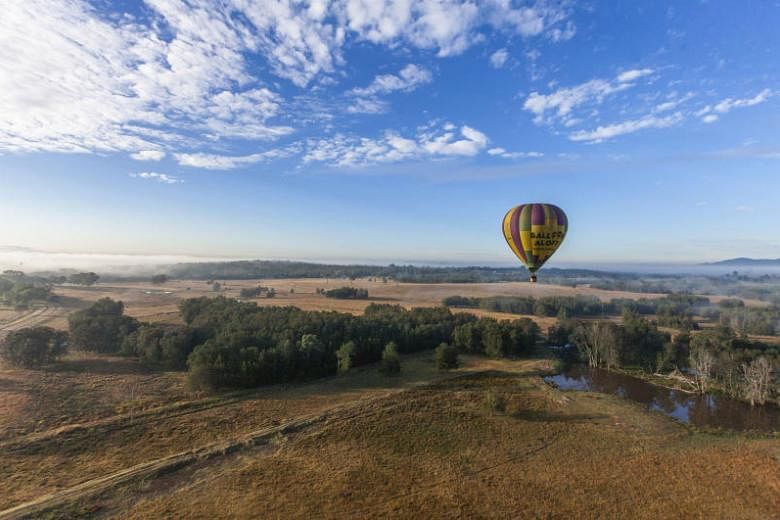NEW SOUTH WALES - It is a brisk morning in Mudgee, New South Wales, warmed by the roar of propane burners that lift our hot-air balloon (www.balloonaloft.com) off a rugby field.
As we gain height, houses shrink into child-sized dioramas and Mudgee's pastoral, laid-back charm comes into focus.
In the wide expanses of green, I identify the movements of various animals - a herd of sheep bleat as they run in unison; a lone brown hare lopes through a field; a mob of kangaroos bound through neatly manicured vineyards.
Mudgee is also a wine region, three hours by road from iconic wine region Hunter Valley and far less touristy. That makes it more beautiful, according to hot-air balloon pilot Sanshiro Ishihara, who regularly conducts flights over both regions.
Just a skip and a hop away from Australia's most populous city lies food, wine and adventure invitingly spread across regional New South Wales.
Mudgee may be less well known among international travellers, but it is a popular weekend destination among Sydneysiders, who come for its boutique wineries, organic vineyards and hearty meals served in convivial settings.
Over dinner at modern Australian restaurant The Zin House (www.zinhouse.com.au), which grows and farms most of the produce on its set menu, I share a farmhouse table with a couple visiting from Dubbo, a 11/2 -hour drive away.
Their weekend trip is a celebration; it is their third anniversary and they are expecting their first child next year.
My guide leans over and whispers conspiratorially: "What are you going to name the baby? We're strangers, you can tell us." They laugh and reveal two names - one each, for a boy and a girl.
These are the sort of conversations that arise, easy and often, over my two days in Mudgee.
At organic winery Lowe Wines (www.lowewine.com.au), owner and winemaker David Lowe regales a group of guests with the names behind his rose wines.
For instance, Jodie Wilbetree, a light, sparkling crowd-pleaser, is a combination of Lowe's first pet Jodie, and Wilbetree Street in Mudgee, where he grew up.
At the Baker Williams Distillery (www.bakerwilliams.com.au), which makes handcrafted spirits and liqueurs, I sample the creamiest, richest version of butterscotch schnapps I have ever tasted. Owner Nathan Williams lets on that when his wife Helen suggested the flavour, he had dismissed the idea.
"She said, 'I'll make it myself.' Now it's our bestseller," he tells me with a laugh.
After all this indulgence, there are many boutique hotels to bed down at in Mudgee, housed in well-preserved historic buildings. But Sierra Escape (www.sierra escape.com.au), a glamping site located 25 minutes from the town centre, offers a unique experience.
The dirt road leading in is part of the adventure - we are flanked by kangaroos and livestock, with no other humans or cars in sight.
The remoteness is part of the appeal. My tent, which seems to be designed for couples, has a bathtub on the verandah overlooking the Australian bush, where I watch the sky darken into soft pastel hues.
While these holiday homes are called tents, they feel more like cottages, complete with sliding doors, plush beds, hot showers and flushing toilets.
Still, Sierra Escape bills itself as eco-glamping and this means it is powered by solar energy - power sockets are meant to run only low-wattage appliances and in the cooler months, the only source of heat is from a fireplace.
During my visit in September, the temperature at night is about 8 deg C.
As a city-dweller, I have never made a fire before, but it is not too difficult with the material supplied: fire starters, a lighter, a bucket full of kindling and an ample supply of large logs.
There is something primal about adding fuel to my fire, hearing the kindling crackle and finally getting the logs to ignite.
I fall asleep to the chorus of a roaring fire and the canvas tent walls flapping in the gusty wind, leaving the curtains open so that I will wake up to yet another paddle pop sky.
On the four-hour drive from Mudgee to the coastal region of Port Stephens, the view morphs from verdant green vineyards to the sparkling blue of the ocean.
Port Stephens is a family-friendly destination, a way to show the kids a slice of nature.
On a dolphin-watching cruise (www.moonshadow-tqc.com.au), toddlers and adults gasp in unison at our first glimpse of the sleek mammals.
The calm waters of the estuary, about 21/2 times larger than Sydney Harbour, is ideal for spotting the creatures' grey dorsal fins and sleek bodies.
Our vessel is equipped with an underwater camera to capture the dolphins as they swim under the hull of the boat. But they are more impressive in the flesh, splashing playfully near the bow, so close that I can make out their blowhole and the smooth, rubbery texture of their skin.
With over one hundred dolphins living in Port Stephens, there are other opportunities to spot these aquatic mammals.
Mr Mick Todd, who takes me on a snorkelling trip from the Fly Point dive site, says he sometimes spots dolphins far out in the waves.
"Dolphins are elusive creatures," says the operations manager of Let's Go Adventures (www.letsgoadventures.com.au). "They know how to hide from humans if they don't want to be seen."
For the next hour, I am distracted by schools of bream, luderick and the occasional knife-like garfish as we snorkel from Fly Point to Little Beach, a distance of about 300m. At the end of the swim, just when I remove my mask, Mr Todd points out a dorsal fin in the distance - but by the time I follow his gaze, all I see is the water, shimmering under the afternoon sun.
Later, over a delicious seafood lunch at the Little Beach Boathouse (www.littlebeac boathouse.com.au), I glance up from my prawn cocktail and catch sight of a pair of dolphins arcing through the water. I watch them swim for a distance and feel like I am living in a dream.
There are other animals in Port Stephens too, on other landscapes. At Birubi Point, the northernmost point of 32km-long Stockton Beach, a line of 10 camels wait languidly on the sand for their next customers.
Camels are not often associated with Australia, but over a million of them currently roam the Outback. Camels were brought over from the Middle East in the 19th century to do transport and heavy work, and their large, padded feet cause less soil erosion than hard-hoofed animals such as horses.
Mr Rod Sansom, who owns Oakfield Ranch (www.oakfieldranch.com.au) shares these nuggets just before I mount a camel for a 20-minute ride along the beach. The ride is undulating but never uncomfortable; the camels' height offers a good vantage point across the expanse of sand.
There are sandboarding and sand-dune bashing rides along the same beach, but I wait until the next day to venture further, to the Worimi Conservation Lands about a 40-minute drive away.
The sand dunes here, touted as the largest moving coastal dunes in the southern hemisphere, cover ancient Aboriginal sites. All-terrain vehicle (ATV) tours run by Sand Dune Adventures (www.sandduneadventures.com.au) are as much an adventure as they are a cultural immersion.
Riding through the bush on the way to the dunes, guide Rachel Syron points out bush tucker - native plants with all kinds of practical uses that were first used by Aboriginal Australians.
Dry banksia cones can be used to transport fire; the pods of bracken fern are edible; the carpobrotus succulent more commonly known as pig face is rich in moisture and its fruit tastes like kiwi when ripe.
As we enter the dunes, the landscape turns otherworldly. For a while there is nothing but mounds of fine white sand stretching far into the distance, and a cloudless blue sky overhead. It is my first time driving an ATV, but the vehicle is easy to control - all I have to do is steer firmly with the handlebars and follow the tracks ahead.
Ms Syron leads us on a winding route across the dunes, which can reach up to 40m high.
We stop to sandboard our way down from the top of one dune. The drop looks intimidating while I am perched on a tiny sandboard peering over the edge, but Ms Syron shows me how to control my speed by digging two fingers into the sand.
I hesitate a few moments, but eventually gather the courage to slide my way down, laughing.
Later, back on our ATVs, we ride to a small circular, seashell-studded mound. This is a midden, explains Ms Syron, an aboriginal site where people ate, left the remains from their meals and sometimes buried their ancestors. She says: "Middens are a living space, a physical thing we can come and visit to feel connected to our ancestors. Our people shared a meal here under the stars before the land was touched."
Her words follow me as I make the two-hour round-trip hike up Tomaree Head, another beautiful landscape that abounds with symbolism.
Tomaree National Park played an important role in Australia's defence during World War II and includes barracks, torpedo tubes, a radar tower and gun emplacements. Today, only the last one remains and I hike past it on the way to the Tomaree Head summit.
At the peak, watching golden hour descend on Port Stephens, I am reminded that adventure may have brought me to New South Wales, but it is the people, their stories and their histories that will stay with me. •
The trip was sponsored by Destination New South Wales.


